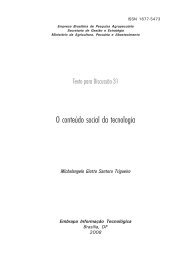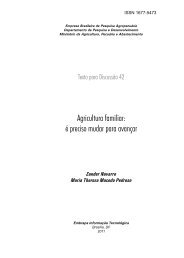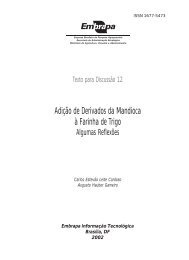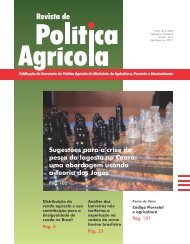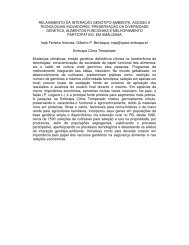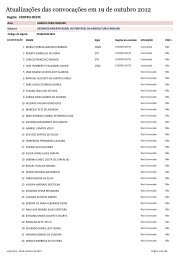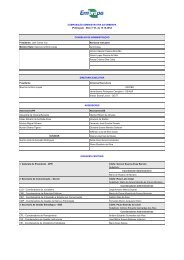Ministry of Agriculture, Livestock and Food Supply - Embrapa
Ministry of Agriculture, Livestock and Food Supply - Embrapa
Ministry of Agriculture, Livestock and Food Supply - Embrapa
Create successful ePaper yourself
Turn your PDF publications into a flip-book with our unique Google optimized e-Paper software.
uncertainties still remain: the corrosive effects <strong>of</strong> biogas on auxiliary equipment<br />
<strong>and</strong> motogenerators <strong>and</strong> the stability <strong>of</strong> biodigestion vis-à-vis the fluctuations<br />
in the quantity <strong>and</strong> quality <strong>of</strong> the vinasse to be processed. These potential<br />
problems could have negative impacts on the future commercialization <strong>of</strong> the<br />
technology, <strong>and</strong> the problems can only be evaluated <strong>and</strong> solved after some<br />
units start operations.<br />
There are numerous electric power plants in developed countries that<br />
run on biogas produced through the bio-anaerobic digestion <strong>of</strong> other substrates,<br />
such as industrial effluents <strong>and</strong> animal wastes. The operational experience <strong>of</strong><br />
those power plants should be used to improve the technical <strong>and</strong> economic<br />
reliability <strong>of</strong> future power plants fueled by biogas from vinasse.<br />
It would be convenient, therefore, to set up some pilot units before going<br />
into industrial scale production <strong>and</strong> provide R&D adequate funds to analyze<br />
said units from the technical <strong>and</strong> economic viewpoints. Because <strong>of</strong> the<br />
potential to generate surplus power, estimated at 3.6 TWh/year12 in that stage,<br />
it would be advisable to introduce the vinasse biodigestion technology <strong>and</strong> the<br />
use <strong>of</strong> biogas in electric power generators at the commercial level, albeit<br />
cautiously.<br />
If the sugar & alcohol activities grow markedly in the next few years as<br />
predicted, the electric power generation potential could attain average values<br />
<strong>of</strong> 16 – 21GW by 2025.<br />
Nevertheless, this effective economically viable power, which already<br />
falls below 65% <strong>of</strong> the theoretical power, is produced by only a few power<br />
plants. In the other units being set up or enlarged, ongoing investments<br />
contemplate the adoption <strong>of</strong> less efficient technological solutions, which will<br />
limit the effective additional power to 0.5 – 2 GW in the next five years, even<br />
after exp<strong>and</strong>ing the sugarcane production. More advanced technology<br />
configurations could increase the effective surplus power to 3 – 6.4GW by<br />
2010, <strong>of</strong> which 1.7 GW to 3.8 GW would be economically viable.<br />
In order to make full use <strong>of</strong> the cogeneration opportunities it would be<br />
necessary to replace the main existing power equipment, install it in new<br />
plants <strong>and</strong> enlarge others. Yet this would mean even larger investments than<br />
those being made by most companies <strong>and</strong> businessmen in the energy sector.<br />
For the picture to evolve favorably it is essential to define immediately the<br />
strategy required to make this power generation effectively viable.<br />
12 Considering an energy yield <strong>of</strong> 20 kWh/ton <strong>of</strong> sugarcane <strong>and</strong> a volume <strong>of</strong> 180-million tons <strong>of</strong><br />
sugarcane earmarked for alcohol production.<br />
72



